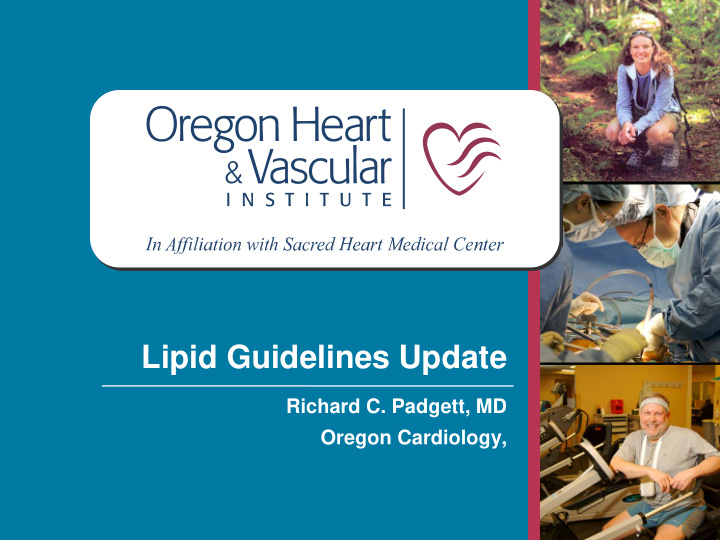



Lipid Guidelines Update Richard C. Padgett, MD Oregon Cardiology,
2
3
Applying Classification of Recommendation and Level of Evidence. Neil J. Stone et al. Circulation. 2014;129:S1-S45
Change can be hard • Class 0 Things that I Believe • Class 0a Things that I Believe, despite available data • Class I RCCT trials that Agree with what I Believe • Class 2 Prospective Clinical Data that agree with what I Believe • Class 3 Expert opinion that agree with what I Believe • Class 4 RCCT trial that Don’t Agree with what I Believe • Class 5 Things that you Believe, that I don’t
New Cholesterol Guideline Myths
New Cholesterol Guideline Myths
New Cholesterol Guideline Myths
New Cholesterol Guideline Myths
New Cholesterol Guideline Myths
11
• ACS, h/o MI, angina, revascularization, TIA, stroke, peripheral arterial disease • No RCTs identified that titrated drug therapy to specific LDL goals to improve ASCVD outcomes
• Often genetic (family screening) • Consider secondary causes − Drugs (diuretics, cyclosporin, glucocorticoids, amiodarone) − Biliary obstruction, nephrotic syndrome − Hypothyroidism, pregnancy* * Statins contraindicated in pregnancy & lactation
• Extrapolation of data for primary prevention in high risk (≥ 7.5% 10 yr risk) who did not have diabetes − Expert opinion, some conflicting data (IIa, B) • < 40 or > 75 yrs the decision to initiate statin therapy should be individualized − Expert opinion, divergent opinions (IIa, C)
• Most controversial area of guideline because of risk equations & lower cut off • Reasonable to offer statin therapy to those with risk of 5- 7.5% [ conflicting evidence (IIa, B )]
17
18
19
Increased in statin utilization (“statinization”)? 101 million people in US aged 40-79 yrs without cardiovascular • disease 33 million expected to have ≥ 7.5% predicted risk • 13 million expected to have 5-7.4% predicted risk • US population 1/20 th global population in this age range • − (33+13) x 20 = 920 million worldwide would be new statin candidates (JAMA 12/2/13) Risk calculator overestimates risk • Lower thresholds to initiate statin therapy •
Why a new risk predictor? Previously used Framingham risk score was not felt to be adequate • because of its “derivation in an exclusively White sample population and the limited scope of the outcome (in determining CHD alone).” Other risk scores also suffered from “nonrepresentative or historically • dated populations, limited ethnic diversity, narrowly defined endpoints, endpoints influenced by provider preferences (e.g., revascularizations), and endpoints with poor reliability (e.g., angina and heart failure [HF]).” Broader outcomes of interest • ASCVD: first occurrence of nonfatal myocardial infarction or CHD • death, or fatal or nonfatal stroke
The Lancet, Volume 382, Issue 9907, Pages 1762 - 1765 External Validation • How many of the 33 million expected to have risk >7.5% actually have risk that is much lower?
What should you do about risk assessment? • Use the pooled risk estimation equations • Use other risk scores (eg Framingham, QRISK, etc) • Ignore any risk assessment and consider that almost everyone benefits from primary prevention • Use eligibility criteria of the primary prevention trials
Other recommendations from the guidelines In lower risk patients (5-7.5%, < 40 or > 75 yrs) clinicians should • discuss with patients: ASCVD risk reduction benefits (30% RRR MIS, 45% HIS) • Adverse effects (diabetes NNH 200) • Drug-drug interactions • Patient preferences • In lower risk individuals also consider: • FH of premature CAD (< 55yo M, < 65yo F) • hsCRP > 2 • CAC score >300 Agatston units (or >75 percentile for age) •
Other recommendations from the guidelines CK should not be routinely measured • Measure baseline ALT and only remeasure if symptoms suggest • hepatotoxicity Screen for diabetes following current diabetes screening guidelines • Muscle symptoms: • Temporarily d/c statin and assess for rhabdo if severe & other • conditions that cause muscle symptoms Rechallenge with lower or same dose of statin • − If statin causative then give lower dose of different statin
Other recommendations from the guidelines • No recommendations for add-on therapy to lower LDL after optimal statin dosing • Separate guideline on triglycerides (Circul 2012) • No gemfibrozil • Fenofibrate only if TG > 500 mg/dl and benefits judged to outweigh risks • Consider rechecking lipid panel 4-12 wks after initiation to assess for adherence but not to adjust therapy
Recommend
More recommend